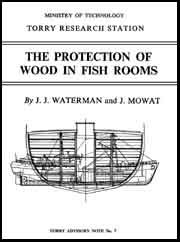Contents Index

Accompanying Notes
Table of Contents
MINISTRY OF TECHNOLOGY
TORRY RESEARCH STATION
By J. J. WATERMAN and J. MOWAT
TORRY ADVISORY NOTE No. 7
Wood in fish rooms requires a protective covering for two reasons - firstly, to provide a hygienic and easily cleaned surface where this comes in contact with fish and secondly, to protect that part between the lining and ship's side from rot and decay, so that it may last for the life of the vessel.
Crown copyright material is reproduced with the permission of the Controller of Her Majesty's Stationery Office.
This electronic document has been scanned using optical character recognition (OCR) software and careful manual recorrection. Even if the quality of digitalisation is high, the FAO declines all responsibility for any discrepancies that may exist between the present document and its original printed version.
Provides useful background information still relevant to vessels with fishrooms of wooden construction, but up-to-date advice should be sought on timber, preservatives, surface finishes, and on current, relevant, hygiene regulations. Defines wood decay, outlines the conditions in which it occurs, and lists the durability of various timbers. Explains the need for good ventilation in fishrooms, provides information on the use of preservatives and paints, and lists the desirable properties of interior finishes in wooden fishrooms. Reports mentioned in the text are no longer available.
(FAO in partnership with Support unit for International Fisheries and Aquatic Research, SIFAR, 2001).
What causes decay?
What are these conditions?
How can decay be prevented?
What are wood preservatives?
What kind of preservative
should be used?
How can preservatives be
applied?
What role does
paint play in wood protection?
What finish should be used on the interior of a fish room?
Contents Index